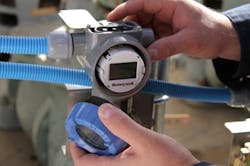Cloud-Based Configuration Offers Down-to-Earth Savings
Field instrumentation increasingly relies on digital communication. So today, project success greatly depends on the ease of configuring devices to exchange data across digital networks. Modern smart devices have highly sophisticated capabilities but configuration remains a mostly manual process. In addition, far too many field devices must be designed for a given application and are heavily customized. This makes them expensive, difficult to change and engineering intensive. It also requires a large amount of documentation and testing.
Fortunately, with the current growth of the Industrial Internet of Things, opportunities exist to deploy cloud-based applications and smart connected assets to reduce the time, money and mistakes associated with instrument design, ordering, configuration and setup. Cloud engineering with integrated tools and automated documentation offers a way to decrease project risk and schedule, lower implementation costs and effort, simplify operations and minimize lifecycle cost, improve efficiency due to less downtime, and enhance safety. Engineering/procurement/construction (EPC) firms frequently achieve upfront savings of 15–30% of engineering cost by putting cloud-based tools to work.
[callToAction ]
Cloud-Based Applications
A new breed of engineering application takes instrument configuration to the cloud, enabling error-free instrument ordering, pre-configuration to simplify installation, and online collaboration to increase project efficiencies. This translates to major reductions in device configuration and setup time. Cloud-based execution also eliminates duplicate engineering effort, minimizes errors and provides a simple “out of box” experience from specification start to installation while slashing testing requirements and commissioning effort.
Figure 1. Configuring loops via the cloud can cut commissioning time to minutes from hours.
With an automated device commissioning capability, engineers can configure control loops via the cloud and cut commissioning time to minutes from hours (Figure 1). Moreover, binding of the physical device in the field is automated with configuration done in the cloud.
Whereas project engineers once dealt with complicated and repetitive tasks in the initial project stages, automated device commissioning allows teams scattered about the globe to perform configuration development and testing. People can collaborate on work using the same tool and don’t need to send information and emails back and forth. All the testing can be done one time — in the cloud — using smart capabilities to time-stamp completed tests and flag future changes to the database.
Cloud-based tools also ease selecting the right instrument and configuration based on the exact parameters of an application (Figure 2) — avoiding costly mistakes upfront in the project. Personnel can use laptops, tablets or cell phones to input technical data about their specific requirements, collaborate with other stakeholders via a cloud infrastructure to expedite engineering decisions, and then determine the optimal setup for the necessary devices on the project. Documentation of the inputted design parameters and instrument configuration preserves engineering work electronically and allows for automated building of a model number for the device that is unique to the configuration requirements. As such, instruments can be ordered and delivered preconfigured, ready to be installed in the field, saving installation time.
In addition, the new web-based tools feature a graphical interface familiar to the younger generation of workers now assuming an increasing role in automation projects.
Putting New Tools To Work
The latest cloud-based configuration and commissioning tools can address a number of persistent challenges. In particular, they can handle one of the most difficult jobs on any automation project: determining where to land a field instrument within the control system. In one sense, this serves as the lynchpin for the rest of the configuration. In another, more traditional view, the entire control strategy paradigm is based on what channel that field instrument is connected to. Make a mistake and the entire control strategy doesn’t work.
With the advent of an automated device-commissioning capability, the inherent intelligence of smart transmitters such as those employing the HART protocol helps do away with time-consuming steps that once were mandatory on every project. It also addresses conventional requirements for a large, centralized marshaling area and enables moving redundant input/output (I/O) into the field.
Modern online tools allow workers to perform initial device configuration, and later functional testing, in the cloud. Once devices are installed in the field and connected to I/O modules, automated device commissioning occurs for each cabinet. This process also documents device configuration and location for future reference.
When a technician connects a HART 6 or 7 device to, for example, a distributed control system (DCS), the system detects the connection and interrogates the device to see the tag name contained in the 32-character string that comes with the HART standard. After determining the device name, the system then configures the respective controller, I/O module and device. This feature obviates hardware changes late in the project because only software requires modification.
Automated device commissioning also eliminates the rigors of programming control systems whenever new instruments are connected. Traditionally, control room personnel had to create a measurement point and program it to work with each new device. An automated device-commissioning tool performs this programming automatically — saving time in creating new measurement points.
Project teams can take advantage of automated device commissioning to simplify and self-document late changes in an automation project. Controller, I/O and server performance can be fully simulated, allowing testing of a system configuration independent of the ultimate hardware platform.
Figure 2. Cloud-based tools ease selecting the correct field device and configuration.
In addition, an automated commissioning tool can serve to locate crucial wiring mistakes such as mismatched instrument channels and automatically update the configuration. Previously, this would have required technicians to spend hours verifying the power supply, checking connections to the I/O modules, etc.
New online configuration tools do have limitations. For example, taking full advantage of auto-detection and configuration capabilities requires use of HART 6 or later devices. For non-HART devices like discrete inputs or outputs, there often isn’t much to configure.
Streamlined Process
Cloud-based tools further improve effectiveness when specifying and deploying large numbers of new field instruments, as is common in a unit expansion. The traditional approach involves a multitude of steps — e.g., selecting an appropriate instrument, choosing suitable options and ensuring their compatibility with each other; then once the device is installed, setting the parameters necessary to optimize performance and enable communication of the right information, testing, troubleshooting, etc. Using a cloud-based tool can save time, reduce costs and minimize risk.
An online application and validation tool can significantly enhance the instrument selection process by providing step-by-step guidance in choosing the best level, pressure and temperature devices for a given project. A validation function helps determine the optimal setup for the instrument application. Then, a configuration function can build a complete device model number, obtain pricing information and place an order.
For example, in a typical tank-gauging application, the required inputs include:
• information about the tank and its measurements;
• details and measurements of any obstacles inside the tank;
• particulars about the product(s) housed in the vessel;
• the anticipated temperature range inside the tank over time;
• the expected pressure variation;
• specifics about any area safety certification necessary; and
• attributes of the connection type needed for the level instrument.
Tools featuring an interactive, graphical representation of the process installation enable the use of pre-defined shapes to illustrate a tank or pipeline, place an instrument in the desired location, and enter process parameters. The application works in the background to choose the right device and identify the appropriate options and configuration for the application. A warning occurs if the instrument is incompatible with the specified service environment. If needed, the user and supplier representative can simultaneously view the application schematic in real-time while discussing changes on the telephone. The application helps eliminate the possibility of mismatched options and other common errors in the ordering process.
The use of a cloud-based application and validation tool also ensures that instruments arriving on site are pre-programmed by the factory based on the information provided during the online specification procedure — eliminating the need for manual data entry using a handheld device or keypad. In this way, configuration work is done only once and instruments are ready for immediate installation upon arrival.
Should an instrument fail in the future, the factory or service representative can call up the original online schematic to view all the application and service parameters, and see where the instrument is installed. This simplifies troubleshooting of device malfunctions, saves time and improves efficiency.
Substantial Benefits
Overall, a cloud-based approach can provide:
• reduced project risk;
• decreased engineering cost and effort;
• improved project efficiency;
• less duplication of engineering effort; and
• fewer configuration errors.
Using automated device commissioning and online instrument application and validation tools becomes even more compelling on large mega-projects involving multiple EPC companies. Advantages here include:
• reduced specification time;
• faster commissioning;
• ease of operation; and
• lower implementation cost.
Thanks to cloud execution for instrumentation scope, project personnel can reconfigure field devices on the run and make changes as needed without significant impact on physical infrastructure. They also can reduce the potential for costly mistakes due to the ability to easily rework any stage of the process.
To sum up, new cloud-based technologies enable both EPCs and end users to realize dramatic improvement in project results. These tools can play a key role in ensuring controls and instrumentation pose the least risk to project schedule, cost and risk while at the same time fostering safe, efficient and reliable plant startup and operation.
AMOL CHAUBAL is senior product marketing manager for field instrumentation at Honeywell Process Solutions, Pune, India. E-mail him at [email protected].




